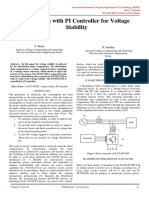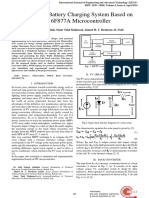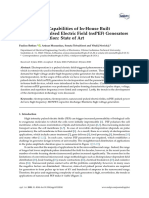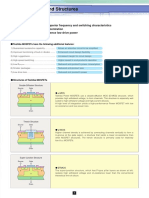Development of A Low Cost Microcontroller Based Under and Over Voltage Protection Device
Development of A Low Cost Microcontroller Based Under and Over Voltage Protection Device
Uploaded by
Abdul KutaCopyright:
Available Formats
Development of A Low Cost Microcontroller Based Under and Over Voltage Protection Device
Development of A Low Cost Microcontroller Based Under and Over Voltage Protection Device
Uploaded by
Abdul KutaOriginal Description:
Original Title
Copyright
Available Formats
Share this document
Did you find this document useful?
Is this content inappropriate?
Copyright:
Available Formats
Development of A Low Cost Microcontroller Based Under and Over Voltage Protection Device
Development of A Low Cost Microcontroller Based Under and Over Voltage Protection Device
Uploaded by
Abdul KutaCopyright:
Available Formats
International Journal of Scientific Engineering and Technology
Volume No.3 Issue No.9, pp : 1225-1229
(ISSN : 2277-1581)
1 Sep 2014
Development of a Low Cost Microcontroller Based Under and Over Voltage
Protection Device
1
Ponnle A. A1, Omojoyegbe M. O.2
Department of Electrical and Electronics Engineering, Federal University of Technology, Akure, Nigeria
2
Works and Physical Planning Department, Samuel Adegboyega University, Ogwa, Nigeria
E-mail: ponnleakinlolu@yahoo.co.uk, meritolutosine@yahoo.com
Abstract This paper presents the design and construction of
a low cost under and over voltage protective device, which was
fabricated using a microcontroller, transistor, IC and other
discrete components. A microcontroller PIC16F877 is at the
heart of the device which performs the major control of the
device. The device is simple and of low cost. It can withstand
loads up to 2KVA and the required set voltage range for the
device to allow supply to the connected load at the output
varies from 200 240 Volts. It can be used to protect loads
such as refrigerator, T.V., VCR/DVD players etc. from
undesirable over and under voltages, as well as surges caused
due to sudden failure/resumption of mains power supply.
This device can be used directly as a standalone equipment
between the mains supply and the load, or it may be inserted
between an existing automatic/manual stabilizer and the load.
The over/under voltage cut-off with time delay provides
over/under-voltage protection, and protection against
transients.
Keywords microcontroller, over voltage, under voltage,
protection.
I.
Introduction
Voltage irregularities are one of the greatest power quality
issues facing industry and home today and often times, is
responsible for damaging valuable electrical equipment.
Electrical Power System protection is required for protection of
both user and the system equipment from fault, hence electrical
appliances are not allowed to operate without any protective
device installed. Power System fault is defined as undesirable
condition that occurs in the power system, and the undesirable
conditions are short circuit, current leakage, ground short, over
current, under and over voltage. The ability of protection system
is demanded not only for economic reason but for expert and
reliable service (Bayindar et al., 2008).
Technically speaking, an over/under voltage condition is
reached when the voltage exceeds/lags the nominal voltage by
10% for more than 1 minute. Short duration voltage events can
also occur such as transients (both impulsive and oscillatory),
sags/dips and swells. Short duration intermittent supply failures
can last anywhere from 0.5 cycles up to 1 minute and can be
IJSET@2014
caused by a number of occurrences such as supply system
faults, equipment failures, or malfunctions in control
equipment. Under-voltage might result into brownout,
distortion or permanent damage while overvoltage in the form
of spikes and surges could cause distortion, burn-out, meltdown, fire, electro-pulsing and permanent damage.
Owing to the incessant damages done by fluctuations in
the power supply, there is dire need to address the problem
through other alternatives, which give birth to design and
construction of an equipment to protect the connected loads
against under and over voltage supply. Under and over
voltage protection is needed between supply terminal and the
appliances (connected loads).
II.
Materials and Methods
The main purpose of the device is to isolate the load from
over voltage and under voltage conditions by controlling the
relay tripping coil using a PIC micro controller. The
microcontroller will compare the supply voltage with the
desired pre-set voltage and will operate the tripping coil in the
relay if the input voltage falls below or above the pre-set
range of values. The under voltage and the over voltage
protective device is shown in block diagram in Figure 1.
Ac Input
Power
Supply
Regulator
LM7805
Relay
Relay
Driver
Input Voltage
Set Voltage
Monitor
Input
PIC16F877A
Micro-controller
Liquid Crystal
Display Unit
Load
Figure 1: Functional Block Diagram of the Under and Over
Voltage Protective Device.
A.
Brief Explanation of Each Block
(1) AC Input: This is the input supply from the public utility
where the device will be energized. It is also supplied directly
Page 1225
International Journal of Scientific Engineering and Technology
Volume No.3 Issue No.9, pp : 1225-1229
(ISSN : 2277-1581)
1 Sep 2014
to the relay contacts in the device which connects the load to the
supply when the supply is within 200V 240V range.
(2) Power Supply: The power supply uses a step down
transformer to step down the input mains voltage to a voltage
level suitable for the electronics within the device. A centre
tapped transformer, with two diodes for full wave rectification
is used to convert the ac voltage to a pulsating dc voltage
followed by a filter, comprising of a capacitor to filter out
(smooth) the pulsation (Close and Yarwood, 1979; Maddock
and Calcuta, 1994; Ian, 2000).
After the rectification and smoothening, a sample of the output
voltage is fed to the microcontroller through a potentiometer.
This voltage is unregulated and therefore varies as the input
mains voltage varies. The output voltage is also passed to an
LM7805 positive voltage regulator to provide a regulated +5V
supply for the micro-controller. The regulator served to reduce
further the ripple and noise in the regulated supply to the
microcontroller. The regulator also provides current limiting
and protects the power supply and attached circuit from over
current (Paul and Winfield, 1989; Delton, 1989). Since the
system is to prevent against over and under voltage, the
transformer was designed and the windings were so selected for
the device to be able to sense and withstand input mains voltage
up to 600Vac.
(3) PIC 16F877A Micro-Controller: The PIC16F877A
microcontroller, performs the major functions of decision and
control. The input voltage monitor is connected to the microcontroller which provides a sample of the input supply voltage
to the microcontroller for comparison with the programmed set
values in the microcontroller. The PIC16F877A microcontroller
was used in the design in order to reduce the complexity of the
design and to ensure an easy interface with a liquid crystal
display.
(4) Input Voltage Monitor: This provides a sample of the
unregulated dc supply voltage through a potentiometer to feed
the microcontroller. It helps the microcontroller to monitor the
supply voltage, as the value of this voltage varies as the input
mains voltage varies. The unregulated dc supply voltage is
scaled down by the potentiometer to values suitable for the
micro-controller. Input mains voltage up to 600Vac can be
monitored.
(5) Liquid Crystal Display (LCD): This displays the supply
voltage as well as some information at switch on or when the
supply voltage is out of range of the desired pre-set range of
values. The LCD used is LM016L having a 2 x 16 display. The
picture of the LCD is shown in Figure 2.
IJSET@2014
Figure 2: The LCD used.
6) Relay Driver: This is an NPN transistor that controls and
supplies current through the coil of the relay that connects the
mains supply to the load. The relay is a single pole relay
which, upon being activated by the PIC via the transistor,
makes under normal mains supply voltage and brakes under
abnormal mains supply voltage.
B.
Relay Driver Design Analysis
The relay driver circuit is shown in Figure 3. The relay
driver uses NPN transistor BC547.
Figure 3: The Relay Driver Circuit.
The relay coil is connected between the positive rail and the
collector of the transistor. When the input signal passes
through the resistor R1 to the base of the transistor Q1, it
conducts and activates the relay RL1. Since a relay coil is not
only an electromagnet but also an inductor (Gurevich and
Vladimir, 2005), a flyback diode D1 in parallel with a resistor
is used to eliminate fly back, which is the sudden voltage
spike seen across an inductive load when its supply voltage is
suddenly reduced or removed. The diode also clamps the
voltage across the coil to about 0.7V protecting the transistor
and other associated components. The stored energy
dissipates quickly in the diode and the resistor. The diode
used is IN4007.
DC current gain of the transistor, is expressed as
(Maddock and Calcuta, 1994),
IC
IB
(1)
where IC is the collector current (through the relay coil), and
IB is the base current.
Page 1226
International Journal of Scientific Engineering and Technology
Volume No.3 Issue No.9, pp : 1225-1229
To calculate the value of the base resistor, the following were
considered:
VIN = 5V (from microcontroller), and the relay that is used has a
coil resistance of 120.
Therefore, the relay coil current = collector saturating current =
ICSAT = 12V/120 = 100mA.
Assuming = 100 (for BC547),
IB
I CSAT
(2)
IB = 100/100 =1mA.
The actual base current flowing, IBSAT must be higher than
the calculated base current IB to ensure base saturation. The
base resistor, R1 must be able to provide this saturating base
current.
Using a 1K resistor would ensure that the transistor is fully
ON when current passes out from the micro-controller 5V
source, i.e.
I BSAT
Vo VBE
R1
(ISSN : 2277-1581)
1 Sep 2014
of components. The calibration is to set the potentiometer for
threshold tripping of the relay in accordance to the pre-set
values in the microcontroller.
To protect the load from switching surges as well as from
quick changeover (off and on) effect of over/under-voltage
relay, in case the mains voltage starts fluctuating in the
vicinity of under or over voltage pre-set points, an on-time
delay was programmed in the microcontroller. When the
mains supply goes out of pre-set (over or under voltage)
limits, the relay/load is turned off immediately and it is turned
on only when A.C. mains voltage settles within the pre-set
limits for a period equal to the on-time delay period. The ontime delay period was made programmable for 500
milliseconds to 20 seconds duration. In the device,
programmed on-time delay of 1 second was found
satisfactory.
(3)
= (5 0.7)/1x103
= 4.3mA which is >1mA.
C.
Explanation of the Circuit Diagram
The circuit diagram of the developed device is shown in
Figure 4. The circuit was designed, and its functionality was
simulated using Proteus Software. The input mains supply is
stepped down by the centre tapped transformer TR1 to 12Vac at
input mains voltage of 220Vac. TR1 with diodes D1 and D3
provide centre tapped full wave rectification, which is
smoothened by capacitor C3. The unregulated dc output is fed to
the positive fixed voltage regulator U1 (LM7805) with regulated
output voltage of +5V.
The PIC monitors the input voltage through a potentiometer
RV3 and toggle switch SW1; set the input voltage range (as
presented by RV3) at which the relay will be energized; and
activates the liquid crystal display LCD1 which displays the
input mains voltage level and other information as the case may
be. The microcontroller sends signal to the relay driver Q 1 and
thus energize the relay RL1 thereby connecting the mains supply
to the load. LED D4 indicates when there is mains supply to the
load. LED D4 used is a high current and high reverse voltage
LED. Diode D5 helps to provide a dc current through the LED
while resistor R2 limits the current to a safe value for the LED.
Diode D5 used is 1N4007.
Switch SW1 was incorporated to allow for manual test and
calibration of the device. The manual test is to ascertain the
functionality of the microcontroller after assembly and coupling
IJSET@2014
Figure 4: Circuit Diagram of the Microcontroller Based
Under and Over Voltage Protective Device.
III.
Construction and Testing
A.
Construction
The design and the programming was simulated several
times on Proteus software until the code for the design
worked satisfactorily before the final programming of the
microcontroller and assembly of the components (Martin,
2008). The microcontroller is shown in Figure 5(a); the type
Page 1227
International Journal of Scientific Engineering and Technology
Volume No.3 Issue No.9, pp : 1225-1229
of programmer used for the microcontroller is a USB
programmer shown in Figure 5(b), and the programming code
used is compiler CCS. The programming of the microcontroller
was done by first writing the program code in C#, after which it
was compiled using the CCS compiler; then later the hex file
was burned to the PIC through the USB programmer.
(ISSN : 2277-1581)
1 Sep 2014
Switch
LCD Display
Potentiometer
LED Switch
5.1cm
(a)
LCD Display
14.5cm
Toggle
Potentiometer
LED Switch
16.8cm
Terminals for Input
Mains Supply
Terminals for
connection To Load
(a)
Input
Mains
Supply
Terminals
Load
Terminals
(b)
Figure 7: (a) Casing dimensions. (b) Completed device.
B.
(b)
Figure 5: (a) The PIC16F877A microcontroller, (b) The USB
programmer that was used.
The circuit was first bread boarded for effective
manipulation of the design, and was tested to ascertain
satisfactory operation. The device was tested based on each
stages of the design. The components were then assembled and
soldered both on Vero board and PCB, and then placed in a
plastic casing. The complete and populated circuit boards were
assembled and coupled in the plastic casing together with
accessories such as output and input terminals, potentiometer
knobs, input power cable, toggle switch, liquid crystal display
and output triggering indicator green light. Figure 6 shows the
device under construction; Figure 7(a) shows the dimension of
the casing, and Figure 7(b) shows the completed device.
Testing
There are two types of test carried out on the developed
device, they are Manual Test and Calibration.
1) Manual Test
During the process of carrying out this test, the toggle
switch was put on the Manual test position. Then, the
voltage protection device was turned ON, and it initially
displayed Please wait on the LCD unit, before the pre-set
input voltage (200-240 volts) was finally displayed. The
potentiometer was varied until mains voltage is supplied to
the load. The purpose of the manual test is to verify the
functionality of the microcontroller.
2)
Calibration
With the switch in Calibration position, the
potentiometer was adjusted to divide down the voltage being
monitored by the microcontroller to a safe value. Also, as the
input mains supply voltage is varied using a variac, the
potentiometer was used to set the threshold for tripping of the
relay. Immediately the output set voltage is reached, the load
received mains supply without any problem.
The completed device was tested with 200W
incandescent bulbs and house appliances such as television,
DVD players, refridgerator, and single phase surface pump;
and the performance was satisfactory. The condition for
output triggering was stable after several testing. The output
set voltage of 200-240 volts was maintained throughout the
test period.
IV.
Figure 6: The device under construction.
IJSET@2014
Conclusion
The aim of designing and constructing a low cost micro
controller based under and over voltage protective device was
achieved in this work. The device supplies power to the
connected load whenever the input supply is within the
required pre-set voltage, thereby protecting the output
connected loads from un-necessary damages. The device is
Page 1228
International Journal of Scientific Engineering and Technology
Volume No.3 Issue No.9, pp : 1225-1229
found to be economical, easier to maintain and repair. The
device cost about $50 to produce.
References
i. Bayindir R., Sefa I., Cola I., and Bektas A. (2008)
Fault Detection and Load Protection Using Sensors, IEEE
Transactions on Energy Conversion, Vol. 23, Issue 3, pp. 734
741.
ii. Close K. J., and Yarwood J. (1979) Experimental
Electronics for Students 1st Edition, Chapman and Hall Ltd,
Britain.
iii. Delton T. H. (1989) Basic Electronic Theory with
Projects and Experiment 3rd Edition; TAB Book Inc. Blue
Ridge Summit, P.A.
IJSET@2014
(ISSN : 2277-1581)
1 Sep 2014
iv. Gurevich H., and Vladimir S. (2005) Electrical
Relays: Principles and Applications CRC Press, LondonNew York.
v. Ian S. L. (2000) Passive Components for Circuit
Design, Texas, USA, p. 170. ISBN 008051359X.
vi. Maddock R. J. and Calcute P. (1994) Electronics:
A Course for Engineers 2nd Edition; Longman Essek,
London.
vii. Martin P. B. (2008) Programming 8-Bit PIC
Microcontrollers in C with Interactive Hardware Simulation
ISBN: 978-0-7506-8960-1.
viii. Paul H., and Winfield H. (1989) The Art of
Electronics, Second Edition, Cambridge University Press,
Cambridge MA, p. 58, ISBN 0-521-37095-7.
Page 1229
You might also like
- Design and Construction of A Low DC Voltage Power Supply UnitDocument28 pagesDesign and Construction of A Low DC Voltage Power Supply UnitRasaq Eneji Jimoh100% (1)
- Temperature Monitoring System FinalDocument49 pagesTemperature Monitoring System Finals_srireddy78% (9)
- Introduction to Power System ProtectionFrom EverandIntroduction to Power System ProtectionRating: 4 out of 5 stars4/5 (2)
- Project Report Speed Control of Induction MotorDocument47 pagesProject Report Speed Control of Induction Motorsrajaprojects0% (1)
- Dosine PublicationDocument6 pagesDosine PublicationDemon GamerNo ratings yet
- Design and Implementation of An Automatic High-Performance Voltage StabilizerDocument10 pagesDesign and Implementation of An Automatic High-Performance Voltage StabilizerMarcel DessapNo ratings yet
- Implementation of A Microcontroller Based 5 KVA Automatic Voltage StabilizerDocument8 pagesImplementation of A Microcontroller Based 5 KVA Automatic Voltage StabilizerMawunyo100% (1)
- Chapter-1: 1.1.1 The Principle of WindmillDocument22 pagesChapter-1: 1.1.1 The Principle of WindmillVijay BavikattiNo ratings yet
- Automation of Maximum Load Control Using 8051-MicrocontrollerDocument7 pagesAutomation of Maximum Load Control Using 8051-MicrocontrollerIOSRJEN : hard copy, certificates, Call for Papers 2013, publishing of journalNo ratings yet
- Implementation of Inverse Define Minimum Time Under and Over Voltage RelayDocument6 pagesImplementation of Inverse Define Minimum Time Under and Over Voltage RelayRika Elvan YulindaNo ratings yet
- Short Circuit Protection in DC Low Voltage System: Matrix Institute of Technology, Eee, Cheekatimamidi 1Document64 pagesShort Circuit Protection in DC Low Voltage System: Matrix Institute of Technology, Eee, Cheekatimamidi 1Santosh KumarNo ratings yet
- Arduino Based Transformer ProtectionDocument8 pagesArduino Based Transformer ProtectionAbdullah MdNo ratings yet
- Wireless I CDocument3 pagesWireless I CkenbobalajiNo ratings yet
- MechanicalDocument5 pagesMechanicalvaneeza ahmedNo ratings yet
- Expt No. 1 Design of Regulated Power SupplyDocument6 pagesExpt No. 1 Design of Regulated Power Supplyrani kumarNo ratings yet
- TN0345 Technical Article: Dual High Side Switches in Smart Power TechnologyDocument9 pagesTN0345 Technical Article: Dual High Side Switches in Smart Power TechnologysathyaeeeNo ratings yet
- Ultra Fast Acting Electronic Circuit BreakerDocument55 pagesUltra Fast Acting Electronic Circuit Breakerpandi60% (5)
- ElectricityDocument21 pagesElectricityChinmay JagadaleNo ratings yet
- Cathodic ProtectionDocument13 pagesCathodic Protectionnamanvyas21No ratings yet
- PTCUL Substation Training ReportDocument24 pagesPTCUL Substation Training ReportChetan Sharma100% (1)
- Transformer Protection SystemDocument57 pagesTransformer Protection SystemAnkit RajNo ratings yet
- Nov 2011 Atul1Document10 pagesNov 2011 Atul1Rajeev RawatNo ratings yet
- Digital Simulation of Thyristor Controlled Interphase Power Control Technology (TC-IPC) To Limit The Fault CurrentsDocument7 pagesDigital Simulation of Thyristor Controlled Interphase Power Control Technology (TC-IPC) To Limit The Fault CurrentstchettoNo ratings yet
- How To Make SMPS Pass Surge & Lightning TestDocument10 pagesHow To Make SMPS Pass Surge & Lightning TestdcasdcasdcasdcNo ratings yet
- Design and Implementation of An Automatic High-Performance Voltage StabilizerDocument11 pagesDesign and Implementation of An Automatic High-Performance Voltage StabilizerRANAIVOARILALA FanomezantsoaNo ratings yet
- Simulation and Implementation of DVR For Voltage Sag CompensationDocument5 pagesSimulation and Implementation of DVR For Voltage Sag Compensationjcrodriguez83No ratings yet
- Report On Power SupplyDocument14 pagesReport On Power SupplyBhavesh MaheshwariNo ratings yet
- Implementation of Dynamic Voltage Restorer (DVR) and Distribution Static Compensator (D-STATCOM) For Power Quality ImprovementDocument7 pagesImplementation of Dynamic Voltage Restorer (DVR) and Distribution Static Compensator (D-STATCOM) For Power Quality Improvementtaner56No ratings yet
- 18.design and Implementation of An Automatic Voltage Regulator With A Great Precision and Proper HysteresisDocument3 pages18.design and Implementation of An Automatic Voltage Regulator With A Great Precision and Proper HysteresisANAND KRISHNANNo ratings yet
- 8 A.) - Various Types of IED SDocument4 pages8 A.) - Various Types of IED SIfiifNo ratings yet
- Emergency Power Supply of Control Rod For RDEDocument9 pagesEmergency Power Supply of Control Rod For RDEKarthick NatarajanNo ratings yet
- Design of Single-Phase Online Uninterruptible PoweDocument6 pagesDesign of Single-Phase Online Uninterruptible Powetshibanguglodi008No ratings yet
- Voltage Sag and Mitigation Using Dynamic Voltage Restorer (DVR) SystemDocument6 pagesVoltage Sag and Mitigation Using Dynamic Voltage Restorer (DVR) SystemUzhansEell-neinoNo ratings yet
- Statcp, XdsadsadsadasasdsadsadsadsadsadsadsadDocument6 pagesStatcp, Xdsadsadsadasasdsadsadsadsadsadsadsadrathorsumit2006No ratings yet
- Regulated Power Supply: T. Y. B.Sc. (Physics) Electronics Dr. Kalange A.EDocument8 pagesRegulated Power Supply: T. Y. B.Sc. (Physics) Electronics Dr. Kalange A.EChristian CalmaNo ratings yet
- SP_202204_Voltage-Distortions_ENDocument8 pagesSP_202204_Voltage-Distortions_ENđức hoàngNo ratings yet
- Power SupplyDocument91 pagesPower SupplyshreekadapaNo ratings yet
- Auto Phase Switching in A 3 Phase SytemDocument10 pagesAuto Phase Switching in A 3 Phase SytemAnshu HilsaNo ratings yet
- Operation 24kWDocument8 pagesOperation 24kWAhmadfakhroii AhmadfakroiiiNo ratings yet
- Iaetsd-Minimization of Voltage Sags and Swells Using DVRDocument8 pagesIaetsd-Minimization of Voltage Sags and Swells Using DVRiaetsdiaetsdNo ratings yet
- Intelligent Monitoring of Ups System: Under The Guidance ofDocument40 pagesIntelligent Monitoring of Ups System: Under The Guidance ofTushar MenonNo ratings yet
- Automated Unified System For LPG UsingDocument84 pagesAutomated Unified System For LPG UsingVirat KaliNo ratings yet
- Coren Write UpDocument20 pagesCoren Write UpBabatunde MartinsNo ratings yet
- Security Alarm For Doors, Almirah, Cupboards Using Opam Design in Protieus 4 1Document30 pagesSecurity Alarm For Doors, Almirah, Cupboards Using Opam Design in Protieus 4 1DebashishParida100% (1)
- D-Statcom With PI Controller For Voltage Stability: A. Sherly G. SusithraDocument3 pagesD-Statcom With PI Controller For Voltage Stability: A. Sherly G. Susithraely nzukiNo ratings yet
- 28W-LCD - Monitor SMPSDocument15 pages28W-LCD - Monitor SMPSPravin MevadaNo ratings yet
- Power Quality Improvement Using Dynamic Voltage Restorer (DVR)Document7 pagesPower Quality Improvement Using Dynamic Voltage Restorer (DVR)ranjithak.nieNo ratings yet
- 9 - 2) DC Power SuppliesDocument39 pages9 - 2) DC Power SuppliesHusamHaskoNo ratings yet
- Design and Performance Evaluation of 2kva Microcontroller - Based StabilizerDocument14 pagesDesign and Performance Evaluation of 2kva Microcontroller - Based StabilizerGAPOSA ElectricalNo ratings yet
- An 18Document12 pagesAn 18teomondoNo ratings yet
- Photovoltaic Battery Charging System Based On PIC16F877A MicrocontrollerDocument5 pagesPhotovoltaic Battery Charging System Based On PIC16F877A Microcontrollerluis martinezNo ratings yet
- Kapasitor MikroDocument5 pagesKapasitor MikroDiki SuryadiNo ratings yet
- Power Diode LectureDocument54 pagesPower Diode LectureMuntasir LamimNo ratings yet
- Voltage Power Supplies: Regulation of UninterruptedDocument5 pagesVoltage Power Supplies: Regulation of UninterruptedhuseyinkaksaNo ratings yet
- Reference Guide To Useful Electronic Circuits And Circuit Design Techniques - Part 2From EverandReference Guide To Useful Electronic Circuits And Circuit Design Techniques - Part 2No ratings yet
- Reference Guide To Useful Electronic Circuits And Circuit Design Techniques - Part 1From EverandReference Guide To Useful Electronic Circuits And Circuit Design Techniques - Part 1Rating: 2.5 out of 5 stars2.5/5 (3)
- Protection of Substation Critical Equipment Against Intentional Electromagnetic ThreatsFrom EverandProtection of Substation Critical Equipment Against Intentional Electromagnetic ThreatsNo ratings yet
- L4970ADocument21 pagesL4970ASURESH CHANDRA ROUTNo ratings yet
- Ex ProcessesDocument7 pagesEx ProcessesJorge RodríguezNo ratings yet
- IECEx OD 021 Ed2.0Document9 pagesIECEx OD 021 Ed2.0Cosmin PuniNo ratings yet
- EECS 100/43 Lab 4 - Linear Op-Amp Circuits: 1. ObjectiveDocument7 pagesEECS 100/43 Lab 4 - Linear Op-Amp Circuits: 1. Objectivespidy_171No ratings yet
- Mosfet - CharacteristicsDocument3 pagesMosfet - CharacteristicsS M Mehedi HasanNo ratings yet
- Screw Compressor Controller PDFDocument28 pagesScrew Compressor Controller PDFMohan Raj100% (1)
- Outline DC Motor DrivesDocument2 pagesOutline DC Motor DrivesAngelica NoquiaoNo ratings yet
- PriceDocument4 pagesPriceCikgu CikguNo ratings yet
- 20.8.2020 Class-1Document21 pages20.8.2020 Class-1abhi shekNo ratings yet
- 7-Grounding Systems PDFDocument67 pages7-Grounding Systems PDF3319826No ratings yet
- Strain Gauges: By: Pinank ShahDocument31 pagesStrain Gauges: By: Pinank ShahAnas EkramNo ratings yet
- Part 5 - Computer Controlled Cranking Circuits - Veejer Enterprises, IncDocument10 pagesPart 5 - Computer Controlled Cranking Circuits - Veejer Enterprises, IncsupljinaNo ratings yet
- Electronics Components SpecificationDocument8 pagesElectronics Components Specificationpratut3335No ratings yet
- MP Filter SelectionDocument6 pagesMP Filter Selectionstefan.minarikNo ratings yet
- Silabus PARDocument6 pagesSilabus PARAmanda Gamayani PendiamNo ratings yet
- Ci Control Velocidad LavadoraDocument12 pagesCi Control Velocidad LavadorailoalNo ratings yet
- Assignment No. 12 With Answer KeyDocument2 pagesAssignment No. 12 With Answer KeySms RajaNo ratings yet
- INDIABIXDocument7 pagesINDIABIXJanicz BalderamaNo ratings yet
- Grounding Part 1Document2 pagesGrounding Part 1Mendoza-Vizcaino, JavierNo ratings yet
- nPEF TopologiesDocument20 pagesnPEF TopologiesVaisakhMohanNo ratings yet
- DIY Laser Burner TutorialDocument24 pagesDIY Laser Burner TutorialArnaldo Canelas67% (3)
- Reverse EDM - Sachin Mastud VJTIDocument57 pagesReverse EDM - Sachin Mastud VJTIDIPAK VINAYAK SHIRBHATENo ratings yet
- tpc8107 26791973Document59 pagestpc8107 26791973Richard BaidooNo ratings yet
- EASA Module 3i MCQ (114 Questions)Document46 pagesEASA Module 3i MCQ (114 Questions)Junaid YounusNo ratings yet
- Zapi H2 Traction ControllerDocument5 pagesZapi H2 Traction ControllerHartanto DwiNo ratings yet
- Power Supplies: Types of Power SupplyDocument18 pagesPower Supplies: Types of Power SupplyArasu LoganathanNo ratings yet
- DC DC Design GuideDocument23 pagesDC DC Design Guidehammouche_soufianeNo ratings yet
- MR2835S Overvoltage Transient Suppressor: Top Can CASE 460Document8 pagesMR2835S Overvoltage Transient Suppressor: Top Can CASE 460R EsfandyariNo ratings yet
- 12f508 509 16f505Document98 pages12f508 509 16f505Leng SovannarithNo ratings yet
- LG W4320S Service ManualDocument24 pagesLG W4320S Service ManualeleandrorobertoNo ratings yet

























































































